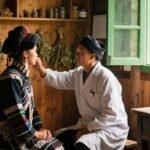Jiyinjian Yangkai (Internal Injury–Induced Fever)
Overview
In Miao medicine, internal-injury fever is called Jiyinjian Yangkai (also Di Yinbian Yang, Shangge Yang, Ga Shang Shekai). It arises from violent trauma that does not break the skin or muscles but disrupts internal qi, blood, and fluids, leading to persistent low-grade fever.
In TCM, internal-injury fever occurs when organ dysfunction, qi–blood–fluid stagnation, or yin–yang deficiency results from internal injury, manifesting primarily as fever.
In Western medicine, functional low-grade fever, tumors, hematologic disorders, connective tissue diseases, endocrine disorders, and some chronic infections—or fevers of unknown origin—can be approached with similar pattern differentiation.
Huhoujipeng · Miao Classification
Six minor patterns:
Cold-disease blood-deficiency fever
Mixed cold–heat qi-deficiency fever
Heat-disease fluid-deficiency fever
Heat-disease meridian-injury fever
Heat-disease blood-stasis fever
Heat-disease damp-toxin fever
Aiduojiang · Causes
Excessive exertion depletes constitution; trauma or falls further injure internal qi–blood–fluids, provoking fever.
Gengduomeng · Pathogenesis
Violent injury disrupts qi, blood, and fluids. Miao theory holds that imbalance of these three fundamentals inevitably leads to disease. Injury to qi also injures blood and fluids; all three are damaged, resulting in internal heat and fever.
Diagnostic Key Points
Diagnosis
(1) Gradual onset, chronic low-grade or subjective fever; chills are mild or absent, fever relieved by covering. Often accompanied by dizziness, fatigue, spontaneous or night sweating, weak pulse.
(2) History of qi–blood–fluid stagnation or yin–yang deficiency, or recurrent low-grade fever.
(3) No external-cold symptoms such as body aches, nasal congestion, runny nose, or floating pulse.
Related Tests
CBC, urinalysis, stool exam, blood biochemistry, ECG, X-ray; immune panels and bone marrow exam assist.
Differential Diagnosis
Guojingshe (Common Cold) features acute nasal–throat symptoms—congestion, runny nose, sneezing, sore throat, body aches, chills—and fever resolving in 3–7 days. Jiyinjian Yangkai is chronic low-grade fever without external-cold signs, often with constitutional weakness.
Pattern Differentiation & Treatment
Cold-Disease Blood-Deficiency Fever
Manifestations: Fever, dizziness, palpitations, pale face, fatigue, night sweats, hot palms/soles, dry stool, scant urine.
Meridian: Cold meridian, cold disease.
Principle: Tonify qi–blood (bu qi yang xue); drain dampness (xing shui).

Formula:
Xiaoyuanzhi (Polygala tenuifolia, xiao yuan zhi) 12g
Huangjing (Solomon’s seal, huang jing) 15g
Lingzhi (Reishi mushroom, ling zhi) 15g
Dangshen (Codonopsis, dang shen) 20g
Shanzhicha (Gardenia tea, zhi zi cha) 10g
Mixed Cold–Heat Qi-Deficiency Fever
Manifestations: Fluctuating fever, dizziness, fatigue, poor appetite, loose stool, spontaneous sweating.
Meridian: Heat meridian, heat disease.
Principle: Strengthen spleen–stomach (jian pi bu zhong); augment qi–yin (bu qi yang yin).
Formula:
Yangquehua (Spiny amaranth, yang que hua) 20g
Dongkui root (Alcea rosea, dong kui gen) 15g
Shan yao (Chinese yam, shan yao) 20g
Baihe (Lily bulb, bai he) 20g
Fangfeng (Ledebouriella, fang feng) 10g
Heat-Disease Fluid-Deficiency Fever
Manifestations: Irritability, insomnia, sweating, dry mouth, flushed face, nocturnal fever, hot palms/soles, dry stool, scant urine.
Meridian: Heat meridian, heat disease.
Principle: Nourish yin and reduce fire (zi yin jiang huo); augment qi (bu qi).
Formula:
Huaxixin (Asarum, hua xi xin) 20g
Baiwei (Cynanchum, bai wei) 15g
Jin ying zi (Cherokee rose hip, jin ying zi) 15g
Baihe (Lily bulb, bai he) 15g
Heat-Disease Meridian-Injury Fever
Manifestations: Post-injury chest/flank fullness, fever, irritability, bitter mouth, menstrual irregularity, breast distension, abdominal pain during menses.
Meridian: Heat meridian, heat disease.
Principle: Nourish yin and reduce fire (zi yin jiang huo).
Formula:
Ku dong zi (Melia toosendan fruit, ku dong zi) 15g
Bai shao (White peony root, bai shao) 15g
Chen pi (Tangerine peel, chen pi) 10g
Shuqucao (Herba violae, shu qu cao) 15g
Shuixu (Pollen, pu huang) 15g
Bohe (Mint, bo he) 8g
Heat-Disease Blood-Stasis Fever
Manifestations: Afternoon/evening fever, hot sensation in body, limb pain/swelling, sallow complexion, dry mouth, dry or scant stool.
Meridian: Heat meridian, heat disease.
Principle: Invigorate blood and resolve stasis (huo xue hua yu); clear heat and detoxify (qing re jie du).
Formula:
Tubiechong (Eupolyphaga, tu bie chong) 15g
Honghua (Red flower, hong hua) 20g
Shan yao (Chinese yam, shan yao) 15g
Zizucao (Viola, zi zu cao) 10g
Puhuang (Typha pollen, pu huang) 15g
Taoren (Peach kernel, tao ren) 10g
Heat-Disease Damp-Toxin Fever
Manifestations: Low-grade afternoon fever, chest fullness, hot palms/soles, dry mouth, poor appetite, irritability.
Meridian: Heat meridian, heat disease.
Principle: Clear heat and moisten (qing re run); tonify qi–blood (bu qi yang xue).
Formula:
Guazijin (Dioscorea seeds, gua zi jin) 12g
Xiangfu (Nutgrass, xiang fu) 10g
Zhi ban xia (Prepared pinellia, zhi ban xia) 10g
Yinxingcao (Herba selaginella, yin xing cao) 12g
Yinchen (Artemisia, yin chen) 15g
Xuchangqing (Radix changqing, xu chang qing) 10g
Prevention & Care
Proper rest and nursing promote recovery.
Patients with internal-injury fever should rest; those with high fever remain bedridden.
Mild chronic cases may do light outdoor activity if able.
Maintain optimistic mood; eat light, nutritious, easily digested foods.
Protect against wind and cold; avoid sweating and re-exposure.
Notes
Miao medicine holds that Jiyinjian Yangkai arises from violent trauma without external wounds, injuring the internal balance of qi, blood, and fluids. Though no skin injury appears, internal disruption of these fundamentals produces chronic low-grade fever.
Disclaimer:
This article is provided solely for the cultural and educational study of traditional medicine. It should not be construed as medical diagnosis or (used in traditional contexts). Before applying any of the therapies described above, you must consult a licensed physician in your jurisdiction.



Leave a Reply